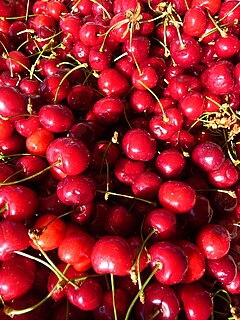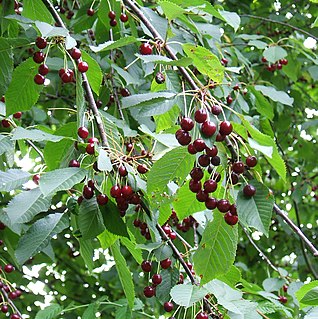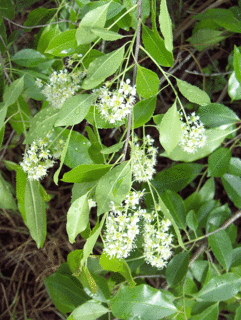
A cherry is the fruit of many plants of the genus Prunus, and is a fleshy drupe.

An apricot is a fruit, or the tree that bears the fruit, of several species in the genus Prunus.

A plum is a fruit of some species in Prunus subg. Prunus. Mature plum fruit may have a dusty-white waxy coating that gives them a glaucous appearance. This is an epicuticular wax coating and is known as "wax bloom". Dried plum fruits are called "dried plums" or prunes, although, in many countries, prunes are a distinct type of dried plum having a wrinkled appearance.

Prunus is a genus of trees and shrubs, which includes the fruits plums, cherries, peaches, nectarines, apricots, and almonds.

Prunus cerasus is a species of Prunus in the subgenus Cerasus (cherries), native to much of Europe and southwest Asia. It is closely related to the sweet cherry, but has a fruit that is more acidic. Its sour pulp is edible.

A cherry blossom is a flower of many trees of genus Prunus. The most well-known species is the Japanese cherry, Prunus serrulata, which is commonly called sakura.

Prunus mume is an East Asian and Southeast Asian tree species classified in the Armeniaca section of the genus Prunus subgenus Prunus. Its common names include Chinese plum,Japanese plum, and Japanese apricot. The flower, long a beloved subject in the traditional painting and poetry of East Asia and Vietnam, is usually called plum blossom. This distinct tree species is related to both the plum and apricot trees. Although generally referred to as a plum in English, it is more closely related to the apricot. In East Asian cuisine and Southeast Asian cuisine (Vietnamese), the fruit of the tree is used in juices, as a flavouring for alcohol, as a pickle and in sauces. It is also used in traditional medicine.

Prunus virginiana, commonly called bitter-berry, chokecherry, Virginia bird cherry, and western chokecherry, is a species of bird cherry native to North America. The natural historic range of P. virginiana includes most of Canada, most of the United States, and northern Mexico.

Prunus subg. Padus is a subgenus of Prunus, characterised by having racemose inflorescences. Some species, such as chokecherries, are used to make jelly and wine in North America.

Prunus padus, known as bird cherry, hackberry, hagberry, or Mayday tree, is a flowering plant in the rose family Rosaceae. It is a species of cherry, a deciduous small tree or large shrub up to 16 m tall. It is the type species of the subgenus Padus, which have flowers in racemes. It is native to northern Europe and northern Asia.

Prunus cerasifera is a species of plum known by the common names cherry plum and myrobalan plum. It is native to Southeast Europe and Western Asia, and is naturalised in the British Isles and scattered locations in North America. Also naturalized in parts of SE Australia where it is considered to be a mildly invasive weed of bushland near urban centers.

Prunus serrulata or Japanese cherry, also called hill cherry, oriental cherry, East Asian cherry, is a species of cherry native to China, Japan and Korea, and is used for its spring cherry blossom displays and festivals. Current sources consider it to be part of a species complex with P. jamasakura and P. leveilleana, which have been reduced to synonyms.

Prunus serotina, commonly called black cherry, wild black cherry, rum cherry, or mountain black cherry, is a deciduous tree or shrub of the genus Prunus. Despite being called black cherry, it is not very closely related to the commonly cultivated cherries such as sweet cherry, sour cherry and Japanese flowering cherries which belong to Prunus subg. Cerasus. Instead, P. serotina belongs to Prunus subg. Padus, a subgenus also including Eurasian bird cherry, Japanese bird cherry and chokecherry. The species is widespread and common in North America and South America.

Prunus africana, the African cherry, has a wide distribution in Africa, occurring in montane regions of central and southern Africa and on the islands of Bioko, São-Tomé, Grande Comore, and Madagascar. It can be found at 900–3,400 m (3,000–10,000 ft) above sea level. It is a canopy tree 30–40 m in height, and is the tallest member of Prunus. Large-diameter trees have impressive, spreading crowns. It requires a moist climate, 900–3,400 mm (35–130 in) annual rainfall, and is moderately frost-tolerant. P. africana appears to be a light-demanding, secondary-forest species.

Prunus × yedoensis, Prunus × yedoensis 'Somei-yoshino' or Yoshino cherry is a hybrid cherry of between Prunus speciosa as father plant and Prunus pendula f. ascendens as mother. It occurs as a natural or artificial hybrid in Japan, and is now one of the most popular and widely planted cultivated flowering cherries (sakura) in temperate climates worldwide. It is a clone from a single tree, and propagated by grafting to all over the world.

Prunus domestica, the European plum is a species of flowering plant in the family Rosaceae. A deciduous tree, it includes many varieties of the fruit trees known as plums in English, though not all plums belong to this species. The greengages and damsons also belong to subspecies of P. domestica.

Prunus avium, commonly called wild cherry, sweet cherry, gean, or bird cherry is a species of cherry, a flowering plant in the rose family, Rosaceae. It is native to Europe, Anatolia, Maghreb, and Western Asia, from the British Isles south to Morocco and Tunisia, north to the Trondheimsfjord region in Norway and east to the Caucasus and northern Iran, with a small isolated population in the western Himalaya. The species is widely cultivated in other regions and has become naturalized in North America and Australia.

Prunus caroliniana, known as the Carolina laurelcherry, Carolina cherry laurel, cherry laurel, or Carolina cherry, is a small evergreen flowering tree native to the lowlands of Southeastern United States, from North Carolina south to Florida and westward to central Texas. The species has also escaped into the wild in a few places in California.

Prunus subg. Prunus is a subgenus of Prunus. This subgenus include plums, apricots and bush cherries. Some species conventionally included in Prunus subg. Amygdalus are clustered with plum/apricot species according to molecular phylogenetic studies. Shi et al. (2013) has incorporated subg. Amygdalus into subg. Prunus, thereby including almonds and peaches in this subgenus.

Prunus subg. Cerasus is a subgenus of Prunus. Species of the subgenus have a single winter bud per axil. The flowers are usually in small corymbs or umbels of several together, but some species have short racemes. The fruit is a drupe and has no obvious groove along the side. The subgenus is native to the temperate regions of the Northern Hemisphere, with two species in North America, four in Europe, two in North Africa, and the remainder in Asia.


















